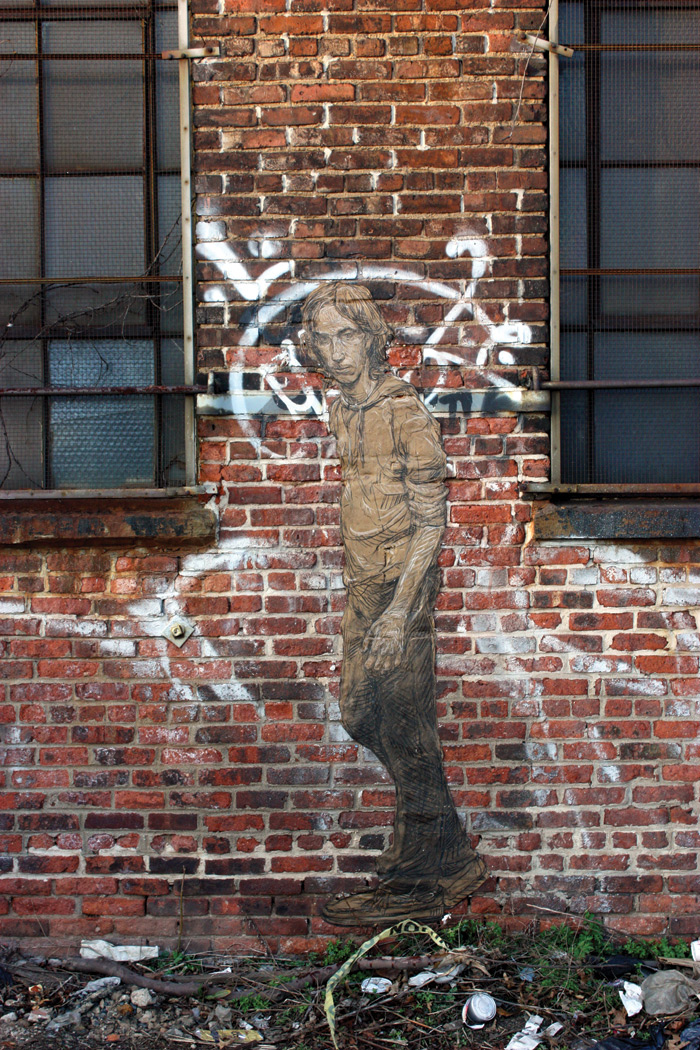RJ Rushmore’s obsession with street art
By Sam Fox
Michael “RJ” Rushmore is obsessed with street art. “I just fell down a rabbit hole,” he says.
Originally from Chicago, Rushmore found his passion when he was living in London five years ago. One day, his father brought home a piece by the Faile street art collective and asked Rushmore if he knew anything about the artist. Rushmore was curious, so he sat down at his computer.
“I was like: I could research this thing or I could do homework.”
That weekend, he started going into East London, which has a lively street art scene. His Saturday trips soon turned into
a “ritual.”
Before his introduction to Faile, Rushmore had not had good experiences with art. He had gone to galleries and gotten sneered at. He was frustrated by the pretension of much modern art.
“I tried to stare at Duchamp’s urinal, and I just didn’t really understand why I was staring at a urinal,” he says. “Street art, to me, is just way more accessible.”
Rushmore believes that the best works of street art make the most of their location and age gracefully.
He remains unimpressed with the “yarn bombing” trend of recent years, which involves knitting projects that cover public spaces. These pieces might look good at first. But then it rains. And they are ruined. And they don’t wash away.
In contrast, Rushmore prefers an artfully placed “wheatpaste”–or a type of glued-on poster–which can become part of its surroundings with time. As it fades, gets written over, and becomes a host to moss, the work manages to gain character and beauty.
Since his transformation in London, Rushmore has fostered his obsession through a variety of solo and collaborative projects.
His critically acclaimed “Vandalog” blog, which chronicles street art around the globe, celebrated its fifth birthday last week.
During his gap year before coming to Haverford College, he curated an exhibit and published a book about it.
Last summer, he interned at Philadelphia’s Mural Arts Program, which asked him to curate an exhibit at their gallery in October. Rushmore also works remotely as a co-curator and liaison for the LISA project, a street art organization in New York City’s Little Italy.
At Haverford, he is a student comanager of the Cantor Fitzgerald Gallery. He also commissions murals at James House, a student art space. Thanks to Rushmore, three of the building’s walls are covered with striking images: a giant black crow, a crowd of colorful people, and a pair of fantastical beasts.
This coming December, he plans to release his second book, which covers street art, graffiti, and the Internet. He argues that the Internet is a kind of “public space” that is changing the way street art is practiced and understood.
It is quite a lot of output for a self-described “twenty-something.”
One can wonder why Rushmore is at a liberal arts school, studying political science. But he says that his time at Haverford has strengthened his work in the art world “for sure.” In particular, he values the lessons learned in John Muse’s conceptual art class. The course made him aware of new meanings in street art and gave him the tools to appreciate art he had ignored before.
Muse’s influence comes through in Rushmore’s blog posts. In his recent series on the work of Banksy, a world-famous street artist, Rushmore argues that the artist’s current work in New York City is less about the pieces and more about the ability to control crowds.
“That thought would have never crossed my mind had I not become open to the idea that conceptual art is a valid thing. That art can be about more than just, you know, putting paint to canvas, but about why that paint is on that canvas.”
If Rushmore has benefitted from Haverford, Haverford has certainly benefitted from him. They, too, have become proud of his obsession. Rushmore was featured in an article in the summer/fall issue of the Haverford magazine; a portrait of him graced the college’s homepage in September.
When asked what makes him good at what he does, Rushmore laughs before answering: “It’s just time and love.”
Looking back on his first blog posts, Rushmore realizes that his work started out rough. But he also knows that successful blogging is not necessarily dependent upon intelligence or knowledge. When guest writers post articles on his blog, the pieces are not always up to par with the author’s expertise. This is because it takes practice to gain a solid grasp of the blog format.
“After five years, I might be wrong,” Rushmore admits. “But at least I have a rhythm.”
As of now, Rushmore does not have plans for after graduation. Though he might like to continue to with the Mural Arts Project in Philadelphia, he would also like to live in New York. While this uncertainty might cause anxiety for some students, Rushmore talks about the future with characteristic humor.
“We’re liberal arts students studying something that’s not science. So, if I can take anything but Starbucks, you know, then I’ll be happy.”

